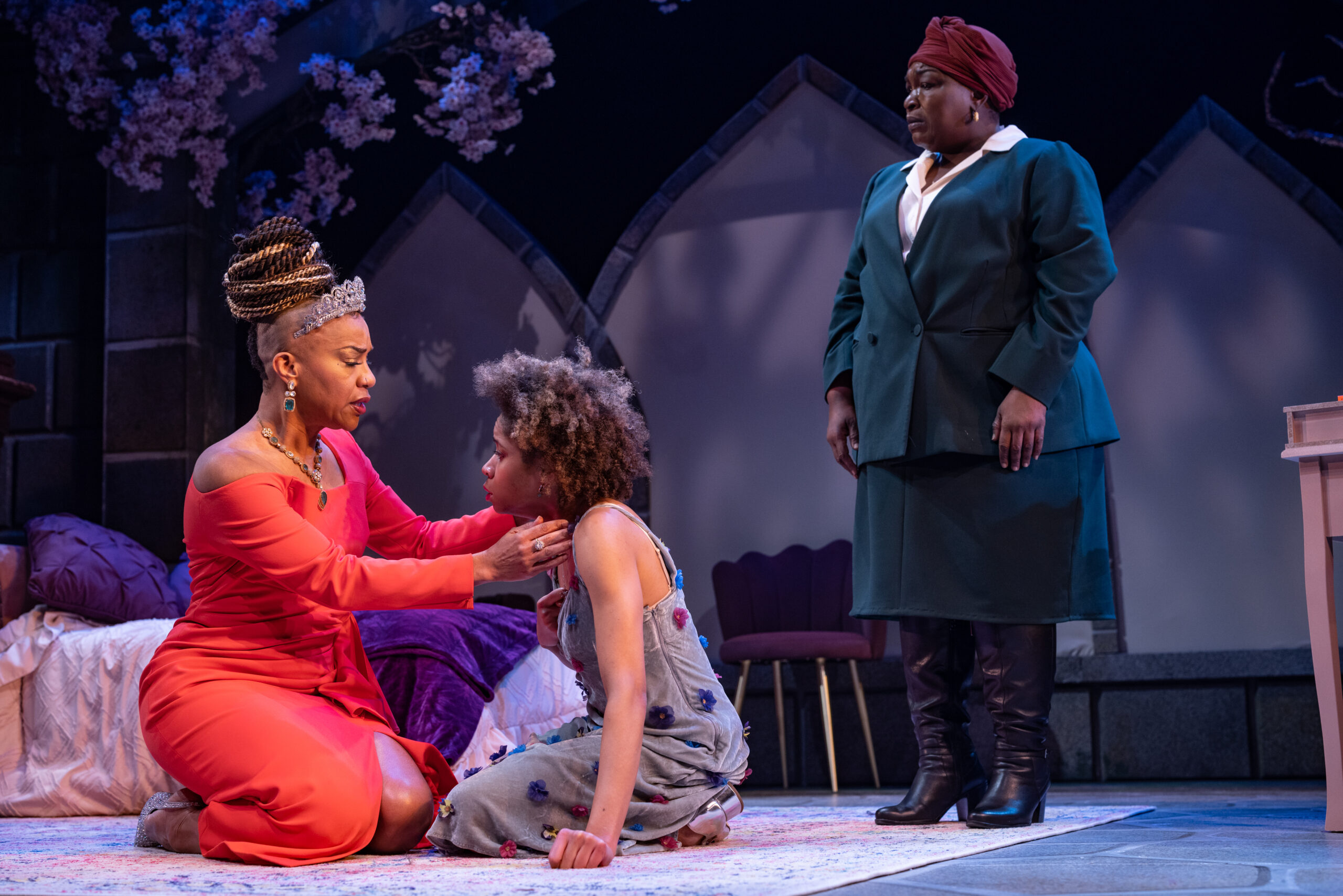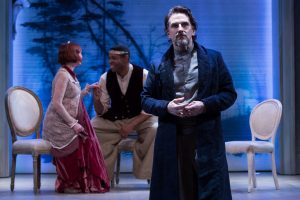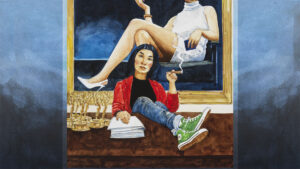For centuries, Shakespeare’s Hamlet has been dominated by the titular prince’s existential turmoil. But in A Room in the Castle, playwright Lauren M. Gunderson shifts the perspective, handing the narrative over to Ophelia, Gertrude, and a new character, Ophelia’s handmaid Anna. The result is a bold reimagining that pushes the women of the classic tale to the forefront of the story. Making its world premiere at the Folger Theatre in a co-production with the Cincinnati Shakespeare Company, A Room in the Castle is a defiant, hopeful, and deeply resonant take on one of literature’s most enduring tragedies.
Under the deft direction of Kaja Dunn, A Room in the Castle reframes Hamlet’s world as a battleground not just for power but for women’s agency and survival. As chaos and violence unravel around them, Ophelia (Sabrina Lynne Sawyer), Queen Gertrude (Oneika Phillips), and Anna (Burgess Byrd) struggle to carve out a future beyond the confines of Shakespeare’s script. Sawyer’s Ophelia is both fierce and fragile, a young woman grappling with love, duty, and the suffocating weight of the court’s expectations. Phillips’ Gertrude brandishes regal authority and emotional depth, especially in her moments of reflection on power and sacrifice. And Byrd’s Anna, a wholly original addition to the world of Hamlet, provides a grounding presence, her voice echoing the struggles of women erased from history. Her character allows the audience to see how the original story undercuts not just the lives of the royal women, Ophelia and Gertrude, but also all of the characters behind the scenes: the handmaids and staff who keep the castle running. As they argue, drink, and grow their friendship, their chemistry is electric, making their shared moments of resistance all the more compelling.
Through sharp-witted (though sometimes overly-buzzwordy) dialogue, humor, music, and moments of quiet solidarity, Gunderson crafts a story that asks whether the women of Elsinore must remain bound to Shakespeare’s tragic fate—or whether they can rewrite their own ending. By relegating the original dialogue of Hamlet to projected, one-line summaries, the play redefines the margins of the story. For example, rather than acting out the initial scene in which Hamlet sees his father’s ghost, that entire interaction is skipped over—marked only by a projection stating that the “Ghost Scene” has just occurred. Where Gertrude and Ophelia are comparatively flat, quiet characters in Hamlet, A Room in the Castle flips the script, quite literally silencing Hamlet and the other male characters—completely removing both their dialogue and their representation on the stage.
Similarly, Gunderson allows Gertrude, Ophelia, and Anna to change the ending of the original play, asking the question: what if the Hamlet we all know and love, the Hamlet that is so central to English education, was different? By suggesting that the story’s ending did not occur in the way the original work says, the play makes the audience reevaluate what they know about the story. If, as the play suggests, Ophelia’s story did not end in tragedy, why does Hamlet make us believe that it did? A Room in the Castle forces viewers to question who is represented and how, encouraging us to take a closer look at the characters often pushed out of the main narrative.
Gunderson’s script is sharp and contemporary without sacrificing the poetry of its Shakespearean origins. It playfully engages with the most iconic lines from Hamlet, like pointing out that maybe “to be or not to be” isn’t such a hard choice after all? The changes to the original offer new layers of meaning while subtly critiquing the limitations imposed on its female characters. The play’s central question—must these women accept their fates, or can they reshape their story?—feels especially urgent in today’s conversations about gender, autonomy, and historical narratives.
The production’s technical elements further enrich the play’s themes. Nicole Jescinth Smith’s costumes blend period elegance with modern touches, emphasizing the women’s constrained yet evolving roles. Max Doolittle’s lighting and Sarah O’Halloran’s sound design create an atmospheric tension that underscores the play’s urgent questions about power, choice, and freedom. The choice to use loud, foreboding sound effects and darkening the lights only when referencing scenes from the original play, further emphasizes how the women feel trapped by the narrative of Hamlet.
Samantha Reno’s scenic designs are a star of the show—imposing, confining, yet also distinctly feminine; they manage to emphasize how the women of Denmark are trapped by their surroundings. Ophelia’s bedroom is draped in pink and framed by flowers but, for all its beauty, she remains frustrated that she is not allowed to leave the castle. In centering the show around Gertrude and Ophelia’s bedrooms, the sets highlight an aspect of the original story that was cast aside. Reno shows how actions done off-stage, in private, are often equally as important as what is presented on stage.
Ultimately, A Room in the Castle does more than just retell Hamlet from a different angle—it demands a reconsideration of who gets to tell stories and why. This is not a tale of passive women caught in a prince’s downfall but of women who refuse to be defined by another’s tragedy, instead working to change the narrative in their own unique ways. In breaking the glass of Shakespeare’s mirror, Gunderson and Dunn leave their audiences both hopeful and full of questions about who controls the narrative in what we consider a “classic.”





